On the Best American Poetry blog, Sherman Alexie explains the process of guest-editing Best American Poetry 2015. He also addresses a controversy that's swirling around the book:
I chose a strange and funny and rueful poem written by Yi-Fen Chou, which turns out to be a Chinese pseudonym used by a white male poet named Michael Derrick Hudson as a means of subverting what he believes to be a politically correct poetry business.
Alexie talks about the process of selection, how he felt when he found out Yi-Fen Chou was a ruse, and why you'll still find the controversial poem in the book when it's published this fall. Alexie is taking a lot of heat for this decision, but you can't accuse him of obfuscating the process. His transparency in the face of this controversy — did poetry really need its own Hugo Awards-style mess? — is to be commended, even if you disagree with his decision.
And if you're a white male writer who is complaining about political correctness as a roadblock to your success, let this white male offer you a piece of advice: putting on another culture like a Halloween costume is not going to win you friends or fans. It's not going to prove a point. It's just going to make people furious at you, and rightfully so. And in the years and decades to come if you're ever remembered at all, it will be as the white male writer who pretended to be another race because he was a total asshole and on the wrong side of history. That's not a legacy, it's just a stinkbomb tossed into a room full of unsuspecting and well-intentioned people.
Priscilla Long's Crossing Over: reading on September 19th
Our sponsor this week is Priscilla Long. You may know her from her fanastic work The Writer's Portable Mentor. Her new poetry collection Crossing Over is being released, and she'd like you to join her at Elliot Bay Books on September 19th at 7pm for her book launch and inaugural reading.
Read a poem from the collection on our sponsorship page, and mark the date. This is sure to be a fascinating reading. Tell her you found out about it on the SRoB.
Our sponsors are not big corporations. They are working writers, artists and publishers who need a channel to reach out to the reading public. Please take a look, and help us make advertising on the internet something we look forward to.
Your Week in Readings: The best literary events from September 7 to September 13
MONDAY Celebrate Labor Day at Bumbershoot, where the Words & Ideas Stage hosts a discussion between local authors Timothy Egan and Jamie Ford, with moderation from Portland Magazine editor Brian Doyle. Egan, of course, is a New York Times contributor and the author of some fantastic non-fiction history books. Ford wrote the Seattle-set novel Hotel on the Corner of Bitter and Sweet.
TUESDAY Elliott Bay Book Company hosts Anita Feng, a local poet and zen teacher who just published Sid, a contemporary retelling of Siddhartha. Press materials say that “Sid teaches that the key to the story of the Buddha's life is that the story could be about any of us.”
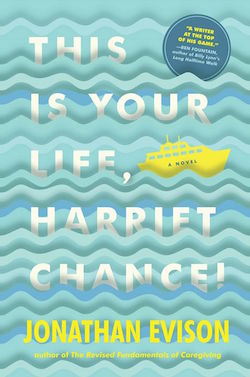
THURSDAY When an event is titled “Wave in the PNW: An Evening with Wave Books,” you’ve got our attention. Wave Books is one of the most ambitious publishers of poetry in America today, and tonight, they’re bringing five Pacific Northwest authors to town. Tonight’s readers are Alejandro de Acosta, Joshua Beckman, John Beer, Cedar Sigo, and Don Mee Choi, who is one of the best poets in Seattle right now. Seriously, this is a roster that’s gushing with talent — Beckman and Sigo have rocked my world in past readings — but I can’t wait to read Don Mee Choi’s forthcoming collection.
FRIDAY It’s time again for the Hugo House’s Literary Series, in which three authors and a local band produce new work based around a theme. Tonight’s readers are novelists Dinaw Mengestu and Alissa Nutting, along with wonderful local poet Sarah Galvin. The Foghorns will perform new songs. The theme — this year’s Literary Series is all about cliches — is “Beating a Dead Horse.” Somehow, I think this is the theme Sarah Galvin was born to write about.
SATURDAY Head on out to the Bellevue branch of University Book Store for what sounds like a fascinating book. Here’s the pitch: “Over a decade ago, W. Ernest Freud, the only one of Sigmund Freud's grandchildren to become a psychoanalyst, asked Bellevue psychologist Daniel Benveniste to write his biography.” Tonight, Benveniste debuts the biography, which is titled The Interwoven Lives of Sigmund, Anna and W. Ernest Freud: Three Generations of Psychoanalysis. Imagine the kind of apple that family tree must’ve produced.
SUNDAY Capitol Hill rum bar Rumba is an unconventional place to hold a reading, which means we’re all for it. Tonight, author Adam Rakunas presents his novel Windswept, which is a science fiction story about a labor organizer who wants to open a rum distillery. Yes, and it all happens in space. You just can’t resist that kind of a premise.
The Sunday Post, for September 6, 2015
Book Bias Gets Magnified Between Shortlists and Winners — Some Data
A follow up for those of you who enjoyed the SRoB interview with Nicola Griffith. She posted this week looking at gender bias between the shortlist and winners of literary prizes — this data was drawn from the Literary Prize Data group, the folks who volunteered to put in the hours to collect the data when she put out the call.
Data suggest that the step from literary prize shortlist to winner might be an important inflection point in the operation of unconscious bias against women in the publishing ecosystem.
An Interactive Guide to Ambiguous Grammar
Vijith Assar’s grammar lesson dealing with passive voice, from his McSweeney’s column “Facepalm Pilot: Where Technology Meets Stupidity”. The great thing about this is his build. He starts simple, instructs and builds until he’s reached the complexity of the kind of language we see every day. And then, he drives it all home. Can't recommend this one enough.
As a thought experiment, let’s examine in extremely close detail a set of iterative changes that can be made to a single simple grammatical structure, turning it from a statement taken at face value into one loaded with unrealized implication. This makes for rich writing which rewards – or even demands – close scrutiny.
The Movies of My Youth
The New York Review of Books published this Italo Calvino piece this week, wherein he reminisces on watching movies as a young man in pre-war Italy
Italian spectators barbarously made entering after the film already started a widespread habit, and it still applies today. We can say that back then we already anticipated the most sophisticated of modern narrative techniques, interrupting the temporal thread of the story and transforming it into a puzzle to put back together piece by piece or to accept in the form of a fragmentary body. To console us further, I’ll say that attending the beginning of the film after knowing the ending provided additional satisfaction: discovering not the unraveling of mysteries and dramas, but their genesis; and a vague sense of foresight with respect to the characters. Vague: just like soothsayers’ visions must be, because the reconstruction of the broken plot wasn’t always easy, especially if it was a detective movie, where identifying the murderer first and the crime afterward left an even darker area of mystery in between. What’s more, sometimes a part was still missing between the beginning and the end, because suddenly while checking my watch I’d realize I was running late; if I wanted to avoid my family’s wrath I had to leave before the scene that was playing when I entered came back on. Therefore lots of films ended up with holes in the middle, and still today, more than thirty years later—what am I saying?—almost forty, when I happen to see one of those films from back then—on television, for example—I recognize the moment in which I entered the theater, the scenes that I’d watched without understanding them, and I recover the lost pieces, I put the puzzle back together as if I’d left it incomplete the day before.
A Writing Lesson from Ursula K. Le Guin: In Pursuit of the Gorgeous Sound of Language
The best writing lesson what can be had on the internet, no doubt. LitHub excerpt’s Le Guin’s updated edition of Steering the Craft.
A good writer, like a good reader, has a mind’s ear. We mostly read prose in silence, but many readers have a keen inner ear that hears it. Dull, choppy, droning, jerky, feeble: these common criticisms of narrative are all faults in the sound of it. Lively, well-paced, flowing, strong, beautiful: these are all qualities of the sound of prose, and we rejoice in them as we read. Narrative writers need to train their mind’s ear to listen to their own prose, to hear as they write.
One day left to read two excerpts from J.G. Perkins' The Announcers
Through Sunday, our sponsor Chatwin Books is allowing us run the introduction and a full chapter from J.G. Perkins' The Announcers.
For those who shared it, the American Dream was wonderful. I awakened from part of that dream early and watched, in one way or another, much of the rest of the country follow over several decades. Some are still asleep. Like many of the awakened, I found that my dream had elements of a nightmare. And while I treasure truth above all else, I envy those who are still dreaming.
Read them here. With your help, we can take internet advertising and make it something good.
Rahawa Haile’s short stories of the day, of the previous week, for September 5, 2015
Every day, friend of the SRoB Rahawa Haile tweets a short story. She gave us permission to collect them every week.
Short Story of the Day #241
Samir al-Sharif's "To Make A Living"
Snow in Amman (2015) pic.twitter.com/FaiEmfm8PO
— Rahawa Haile (@RahawaHaile) August 29, 2015Short Story of the Day #242
You're all watching the VMAs and I want you to have a good time and I forgot to post a story so put a word here:
— Rahawa Haile (@RahawaHaile) August 31, 2015Short Story of the Day #243
Joshua Ferris's "The Dinner Party"
New Yorker (2008)
http://t.co/djknaPTSTL pic.twitter.com/Vp1QvWJghD
— Rahawa Haile (@RahawaHaile) August 31, 2015Short Story of the Day #244
Jennifer Maritza McCauley's "Summer Love, On Sidewalks" (2015)
http://t.co/fM12ngKnqK pic.twitter.com/RTTUJeCZcA
— Rahawa Haile (@RahawaHaile) September 2, 2015Short Story of the Day #245
Vincent Scarpa's "Conservation"
Sundog Lit (2014)
http://t.co/AoitAEhMno pic.twitter.com/LsUim99yBQ
— Rahawa Haile (@RahawaHaile) September 3, 2015Short Story of the Day #246
Kashana Cauley's "The Electric City"
The Common (2015)
http://t.co/ygo9l9Em1v pic.twitter.com/5gyoBw3Rel
— Rahawa Haile (@RahawaHaile) September 4, 2015Short Story of the Day #247 pic.twitter.com/3KJSt5mpiG
— Rahawa Haile (@RahawaHaile) September 5, 2015Our literary advice columnist, Cienna Madrid, is taking a vacation for Labor Day weekend. She advises you do the same.
As always, you can always ask Cienna questions about life, reading, and/or your reading life at advice@seattlereviewofbooks.com.
The ballad of Rosie the Riveter
Published September 04, 2015, at 9:50am
Women write about work in a new poetry anthology. It's maybe the most political book you'll read all year. (This is a compliment)
John Oakes, the publisher of OR Books, announced that he's teaming up with novelist Dale Peck to relaunch the Evergreen Review, an influential literary magazine that Oakes describes as "a plugged-in toaster thrown into the placid pool of culture." Evergreen will reappear as a line of books republishing the best of past Evergreen authors (the debut books are by Marguerite Duras, Samuel Beckett and Kenzaburō Ōe) and also as a relaunched magazine that will be "free of charge in an online-only format," featuring "fiction, nonfiction, and poetry from an international array of new and established writers."
It's hard to overstate how important the Evergreen Review was to literature in the 1950s and 1960s. It pushed at the edges of what was considered acceptable, and it announced a dynamic new literary aesthetic that grew to dominate the latter half of the 20th century. You can find some samples of stories from Evergreen contributors like JG Ballard, Gary Indiana, and Vladimir Nabokov on their site.
Of course, it's easy for something like this to fall into a nostalgia act; lord knows we don't need another organization to trumpet how awesome and incredible the 1960s were. (Speaking as someone who grew up in the shadow of the Baby Boomers, that generation has already exhausted their supply of self-aggrandizement.) But if this new incarnation of Evergreen can become something forward-facing and thoroughly modern, it will honor the spirit of the original. Based on OR Books's stellar track record as a publisher, I'd guess Evergreen has a good shot at finding something new to say.
The women problem
Published September 03, 2015, at 12:03pm
The idea that feelings are the province of women's fiction is silly, Mia Lipman argues. Instead, she suggests a new name for fiction about female protagonists.
Thursday Comics Hangover: Raise the Minimum Wage
Every comics fan knows Wednesday is new comics day, the glorious time of the week when brand-new comics arrive at shops around the country. Thursday Comics Hangover is a weekly column reviewing some of the new books that I pick up at Phoenix Comics and Games, my friendly neighborhood comic book store.
Bob Fingerman’s Minimum Wage comics, published by Fantagraphics, were most definitely products of the 1990s. The main character, Rob, dressed in 90s bike messenger chic — mostly black clothing, a wallet chain, chunky boots, some chin hair, a propensity to wear shorts a little too often. He’d blend right in at a Fugazi concert. And though he seemed to consider himself to be an open-minded modern man, Rob’s relationship toward women — especially his girlfriend, Sylvia — was most definitely of the 1990s, too. This was back in the days when Camille Paglia was briefly the world’s most famous feminist, when feminism meant talking openly about the kind of porn you were into, and women were still encouraged to find empowerment by “controlling” the male gaze.
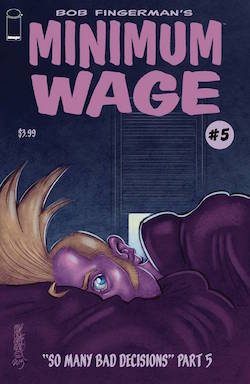
Last year, Fingerman revived Minimum Wage at Image Comics — he also collected the entire original series in an oversized hardcover titled Maximum Minimum Wage — and the new title is very clearly a sequel to the original work. Rob and Sylvia have divorced, and it was apparently a very ugly split; Sylvia only appears in the first revived series as a featured character in Rob’s frequent nightmares. Rob is trying to enjoy being single again, but none of the relationships he seeks out are right for him. He’s enjoying commercial and artistic success, drawing both corporate and semi-autobiographical comics to mostly positive reviews, but he’s also squirming in his skin; nothing turned out as he wanted, and he’s uncomfortable with how uncomfortable that makes him.
Fingerman smartly doesn’t pick the new Minimum Wage up where the old series left off. He’s not afraid to let time have its way with his art. This is most obvious in Fingerman’s illustration, which in the first series was rounded and clean and almost Disneyesque in its voluptuousness. The lines of the new Minimum Wage are noodlier, scratchy, and in some ways uglier. Fingerman still packs tons of rewarding detail into every panel (background characters in restaurant scenes have their own distinct body language, even if they only show up for three panels before disappearing from the book forever) but he’s less prone to care about how realistic things are. (The spray of hair on top of Rob’s head used to be a little Charlie Brown-style curlicue, but in the new series it’s a roosterlike geyser rocketing up from the top of his skull, nearly adding another foot to his height.) The art has become more mature, more concerned with what truly matters, rather than what looks impressive.
Too bad Rob hasn’t grown with Fingerman’s art. Rob’s story in the new Minimum Wage seems to follow one pattern played out over and over again: Rob gets something he wants — a beautiful woman who loves sex as much as he does, an artistic gig that’s fulfilling — and then spends page after page feeling bad about himself. In the latest issue of the comic, #5, Rob wonders to himself, “am I a creep?” It’s probably the closest he’s come to a moment of true self-awareness since we were reintroduced to him last year.
The thing is, in this new Minimum Wage series, we really miss Sylvia. Though the comic has always come from Rob’s perspective, spending this much time in Rob’s head without another regular character to pull him out of his interiority reveals exactly how unpleasant a character he can be. That’s kind of the point; the life of a young freshly divorced man isn’t likely to be a happy one. But it’s hard to imagine new readers clambering on board Minimum Wage at this late date and finding a whole lot to identify with in Rob. This is a comic about alienation, and reading it can be an alienating experience. That’s part of the design; Fingerman knows exactly what kind of a story he’s telling.
Or aspiring to tell, as the case may be: Yesterday, Fingerman told Bleeding Cool in an interview that he has one more series in mind for Minimum Wage, but that sales on the comic don’t justify the continuation of the series. He’d like to complete Rob’s story in either serialized comics or in the form of an original trade paperback, but he might not be able to conclude the comic at all.
That would be a shame; imagine if Woody Allen lost funding for Annie Hall three-quarters of the way through production. Minimum Wage can be a frustrating comic, and the first half of the story now feels like an exercise in 90s nostalgia. But no other comic I can think of is documenting this kind of a quiet life in flux, and very few other cartoonists are putting as much work into every page on a monthly basis. Minimum Wage is worth preserving.
Let's be clear that this post at Web Urbanist is a multi-page list, which is a genre of blog post that usually deserves nothing but scorn. But I'll have to give it a pass, because it's about 14 modern library designs and it's the most beautiful thing I've seen on the internet this week. Every single one of these spaces looks like a wonderful place to read; I especially love the Prague National Library, which looks like a giant cartoon amoeba.
Talking with J.A. Jance about the literature of Seattle
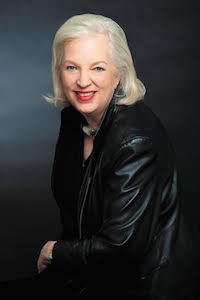
J.A. Jance is the author of more than fifty mystery novels and novellas, parceled out into four distinct series. Arguably her most popular series revolves around Seattle investigator J.P. Beaumont, who has headlined 24 books since his introduction in 1985. Jance has been publishing at least one book a year for three decades, and she’s a bestselling author many times over. Her latest mystery, Dance of the Bones, pairs Beaumont with another of her series protagonists, Sheriff Brandon Walker, for the first time. Next Tuesday, Jance begins a four-day, 12-reading (!!!) tour of Washington state. She’ll be at Seattle Mystery Bookshop, Redmond Regional Library, and the Mill Creek University Book Store at 11 am, 2 pm, and 7 pm, respectively on the 8th. Other appearances include a pair of retirement communities, the Costco in Silverdale, the Bing Crosby Theatre in Spokane at 7 pm on the 10th, and more. Find her full readings schedule on her website.
You write mystery series set in both Seattle and in Arizona. Do you consider yourself a Seattle author?
When I came to Seattle in 1981, I was a divorced single mother with two children, a full time job in the life insurance business, and the long-deferred dream of becoming a writer. I began writing my first mystery in March, 1982, and my first book was published in June, 1985. Yes, my books are set in both Arizona and Seattle. Arizona may be my home — it’s where I came from — but Seattle is my CREATIVE home. It’s where I was first able to set my hand to the serious task of writing.
Do you believe there is such a thing as a Seattle literary tradition?
Of course. Think about Ivan Doig. If he wasn’t literary, I don’t know what is. Or what about Garth Stein’s The Art of Racing in the Rain? Or David Guterson’s Snow Falling on Cedars?
But there is also a long tradition of just plain fiction — think Betty McDonald’s The Egg and I. We’re the people who write the kinds of books that people buy in better bus depots everywhere. Or airports. Or drugstores. Or hospital gift shops. We write to entertain or to help people pass the time and turn away from their own difficulties.
Who are my fellow Seattle-based writers? Robert Dugoni? Check. Jayne Ann Krentz? Check. Stella Cameron? Check. Mary Daheim? Check. The late Ann Rule? Check. Yasmine Galenorn? Check.
Our books seldom merit more than a paragraph in local or national book review pages, but our readers buy them and love them.
That’s literary enough for me.
Our September Bookstore of the Month is Seattle Mystery Bookshop
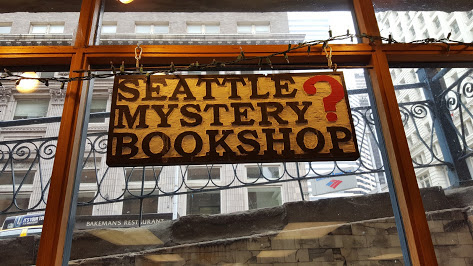
Fran has worked at Seattle Mystery Bookshop for over 12 years. Adele can’t recall if she’s been there for five or six years, but she knows she’s been shopping at the store for 17 years. The transition from one side of the counter to the other seems effortless, in retrospect. “I ran into Fran on the street one day and she told me one of their employees was going to be leaving. She asked if I wanted to apply.” She did. Adele laughs, “I was the one employee JB hired who he didn’t ask ‘...and who do you read?’” After all, he’d been talking books with her for over a decade by that point.
A mystery-only bookstore is a unique pleasure. In a general-interest bookshop, the mystery section tends to look trivial, slammed up against the sci-fi section and overrun by cheap-looking mass-market paperbacks. But in Seattle Mystery Bookshop, a browser can see the nuance of the genre. One display features comedy mysteries. Another contains the first books in recommended series. Many shelves, nearly a full wall, are given over to Northwest authors. A walk around the shop will reveal sections full of rare pulp paperbacks, noir stories, young adult mysteries, a Sherlockiana section, and a true crime section full to bursting with books by local author Ann Rule, who passed away earlier this month. (Seattle Mystery Bookshop employees have a ton of stories about Rule’s many appearances at the store through the years, most of which revolve around the way she treated everyone at her signings with kindness, even the people with glassy stares who demanded she uncover the truth about Kurt Cobain’s death.)
As you may expect for a shop specializing in a genre that leans toward series, Seattle Mystery Bookshop has its share of obsessive-compulsive customers who seek out the latest edition of their favorite detective series on the first day of publication. Fran explains that some of their most frequent customers are “people who are insanely loyal to an author. We love those people.”
And the Bookshop loves authors, too. Novelists will return time and again to the store’s lunchtime signing series. For instance, Fran says, “Jackie Winspear will fly up on her own dime to support us [with a signing] if necessary. Author support has been a big deal” for the store. You’d think staff would get a little blasé about all the novelists floating through, but Fran says “we still fall apart on meeting some authors, make no mistake.” She names a few names — Michael Chabon, Michael Connelly, Jasper Fforde — who freaked even the most veteran booksellers out. Adele proudly says Carol O’Connell “threatened to bitch-slap me” because she was so nervous during an event.
After the signings, every visiting author is asked to sign the store author book. They’re assured that the only other people who will ever see its contents, besides Seattle Mystery Bookshop staff, are other authors. Fran encourages the authors to lean to the naughty side of things: “you can draw pictures, you can be risquee and obscene.” She said for a long time, authors would communicate to each other through cartoons. If you haven’t published a mystery she won’t let you flip through the book, but you might be able to convince her to tell you about some of its contents: Mary Daheim sketched a piece of toast, Anthony Bourdain drew a beautiful picture, Jim Butcher composed a haiku.
As you might expect when booksellers and authors get together, gossip flies. Hang around the shop long enough in one of its comfy chairs and you’ll learn about the nitty-gritty of the mystery industry. On book covers, “cats sell,” and so even if there are no cats in the stories, publishers will frequently try to sneak one onto the front. One author successfully argued with her publisher because the solution to her latest mystery was revealed on the cover. A local author originally set his novel in Seattle, but the editor and publisher insisted that he move the series to New York. Another author claims that her contract is so ironclad that there’s even a clause indicating that her work belongs to the publisher even if humanity discovers alien life and sends the book into outer space.
Pioneer Square used to be the closest thing Seattle had to a publishing district, but now Seattle Mystery Bookshop is one of the last bookstores left in the neighborhood. The shop has a defiant feel to it. The staff saw Pioneer Square decline into seediness — everyone remembers the Mardi Gras riots of 2001 — but now they’re watching it sway back to a trendier part of town, with fancy restaurants opening a few blocks away and new tenants moving in seemingly every day. Some customers still stop by looking for Elliott Bay Book Company, which moved to Capitol Hill in 2010, but more and more, people seek Seattle Mystery Bookshop out as a destination in and of itself.
“I told my friends about you,” a young woman with a gaggle of tourists in tow explains to Adele as she walks into the shop, “and they had to come in and see it for themselves.” Adele welcomes them with a huge smile, tells them to grab a book and sit down and make themselves at home. That’s just what they do.
Swapna Krishna at Panels has collected some tweets by local novelist/comics writer G. Willow Wilson about motherhood and the business of art. Wilson, who's responding to a popular essay by Amanda Palmer, explains that editors and publishers levy "a mommy tax" on writers and other artists.
As contractors, Wilson says, women artists have "zero legal protection," and the story of her own experiences is a real eye-opener: "I wrote ALIF THE UNSEEN while pregnant and edited it with a newborn sleeping on my chest. Toured while pregnant with kid #2....MS MARVEL? First arc outline handed in 48 hours after the birth of Kid #2. First arc written largely while nursing an infant." Go read the whole thread. We desperately need child care and family leave acts in this country.
You have two months to apply for Jack Straw's 2016 Writers Program. Don't know what that is? I'll let them explain:
Twelve writers, selected by an invited curator, create new work during the residency to be presented through live readings, recorded interviews, a published anthology, and as podcasts on our web site. Participants also receive professional training in voice and microphone technique, performance and delivery, and interviews.
Previous Jack Straw writers include Rebecca Hoogs and David Schmader. And this year's program curator is local poet Karen Finneyfrock, who is both an excellent writer and a brilliant reader of her own work, which means that if she selects you for the program, you know you've got something special going on with your bad self. You literally have nothing to lose. Go apply today, and then spend the next two months thinking about all the ways you'll be able to share your work with a solid year of Jack Straw's training.
Lunch Date: Bringing the worst novel in the world out for a salad
(Once in a while, I take a new book with me to lunch and give it a half an hour or so to grab my attention. Lunch Date is my judgment on that speed-dating experience.)
Who’s your date today? Atlanta Nights, a novel that was crowdsourced by nearly three dozen science fiction writers.
Where’d you go? Sprout on the ground floor of the Smith Tower.
What’d you eat? I had the South by Northwest salad, which has all the ingredients you'd expect (steak, romaine, salsa, a cilantro-lime dressing) and some you wouldn't (chili-roasted sweet potatoes).
How was the food? It was great. Sprout is my favorite downtown stop for salads; they're not too heavy and not too light — even the Cobb — and the ingredients are always super-fresh. For about ten bucks, you can get a salad that feels like a meal, but which doesn't feel too weighted down with cheese or goopy dressings.
What does your date say about itself? Adam Rowe at Barnes & Noble's Sci-Fi and Fantasy blog explains that the book was written as a way "to expose 'traditional publisher' PublishAmerica as a vanity press." Rowe says:
The sting operation, organized by author and vanity press-buster James D. Macdonald, aimed to create a book designed to be disturbingly bad. He rounded up a host of co-conspirators, among them some of the most popular (and even award-winning) writers in the genre; Sherwood Smith, Adam Troy-Castro, Allen Steele, and Megan Lindholm (aka Robin Hobb) were among those who contributed chapters under intentionally vague guidelines. No one knew any details about the plot, character backgrounds, or even where their chapter would fall in the book.
In the final draft, chapter 21 was missing, replaced by a second chapter 12. Chapter 4 was identical to chapter 17. Chapter 34 was entirely generated by a software program. Reading Atlanta Nights is like experiencing an art project: the text might be justified to the center or to the right at a whim, and page 119 is entirely blank for no discernible reason.
You can read the whole book online for free.
Is there a representative quote? Try this on for size:
The Atlanta sun slanted low in the west, rain showers predicted for later that afternoon, then clearing. Bruce Lucent looked from the side window of his friend's shiny Maserati sports car as they wheeled their way westward against the afternoon traffic.
"I'm glad you could give me a ride," Bruce Lucent muttered, his pain-worn face reddened by the yellow sunlight. "What with my new car all smashed and all."
His old friend, Isadore, shook his massive head at him. "We know how it must be to have a lot of money but no working car," he said, the harsh Macon County drawl of his voice softened by his years in Atlanta high society. "It's my pleasure to bring you back to your fancy apartment, and we're all so happy that y'all is still alive. Y'all could have been killed in that dreadful wreck." Isadore paused to put on the turn signal before making a safe turn across rush-hour traffic into the parking lot of Bruce Lucent's luxury apartment building. "Y'all'll gets a new car on Monday."
"I don't know how I'll be able to drive it with my arm in a cast," Bruce Lucent shoots back. "It's lucky I wasn't killed outright like so many people are when they have horrid automobile wrecks."
"Fortunately, fast and efficient Emergency Medical Services, based on a program founded by Lyndon Baines Johnson the 36th President of the United States helped y'all survive an otherwise, deadly crash," Isadore chuckled.
Will you two end up in bed together? I think so, yes. I've never read something more equivalent to the kind of cheesy thrill you get from a so-bad-it's-good movie like The Room or Showgirls. Half the fun of reading Atlanta Nights is imagining the writers making themselves laugh as they type it out. Some of the lines are so incredibly dumb that they demonstrate real sharpness, like the one about "Andrea who never came on time unless she happened to be laying on someone’s watch during sex." It takes a lot of work to craft a line that terrible. I can't read Atlanta Nights all in one sitting, but as a work of comedy it's a unique thrill.
Robert Montgomery's "The Stars Pulled Down for Real" is excellent public poetry
Every Tuesday morning, we present a poem for you to enjoy, but this week we're going to do something a little different. I want to call a piece of public art to your attention. Robert Montgomery's poem "The Stars Pulled Down for Real" is the latest site-specific artwork at All Rise, the public art space located between Denny and John, down in the Denny Triangle. All Rise's website explains Montgomery's work as "confront[ing] a post-utopian current while echoing a full, at times romantic, chronology of a land divided, shaped, and built ever-upward."
I think "post-utopian" is maybe a bit too hopeful; I'd call it downright dystopian in places, with our love affair with the road described as "the beginning of a contagion" and people chastised as "ignoring the time of the ice cap melts" and wondering "how will they remember the oil age."
This site, remember, is on an incredibly busy road, a major exchange leading to I-5, and so in many ways it's science fiction colliding with the present-day city around it. This is a vision of a future generation struggling to remember the crisis that brought ruination upon them, right in front of a round-the-clock display of the technology that brought the ruination in the first place. In some ways, it's like Montgomery is putting up yellow crime-scene tape around a murder in progress.
But there's hope in there, too! Or at least an appreciation of "the city" as "a magical sculpture we live inside," even if Montgomery is envisioning the skyscrapers (which are at your back if you're reading the billboard) as a post-human landcape with eagles living ("not as symbols/just as eagles") on them as repurposed clifftops. The city will survive us. The city will always be put to good use, even if we're not around to be the ones who use it.
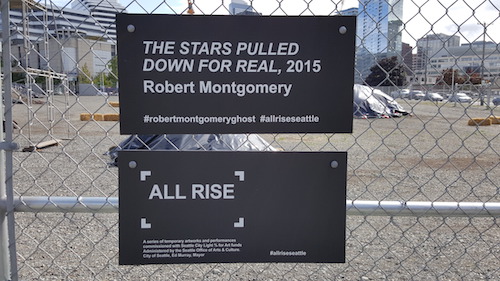
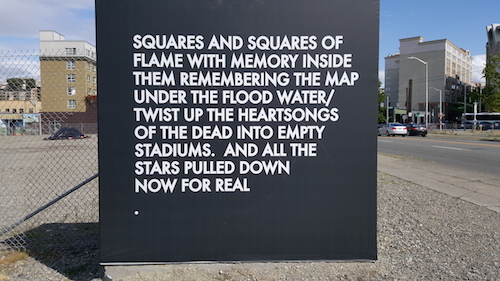
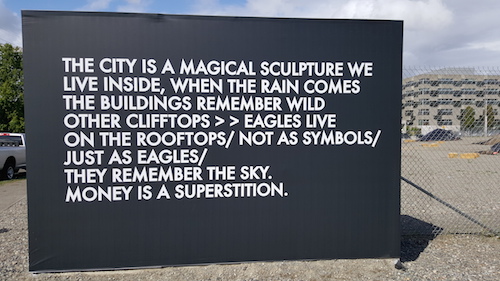

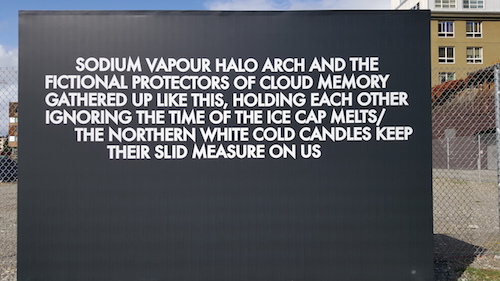


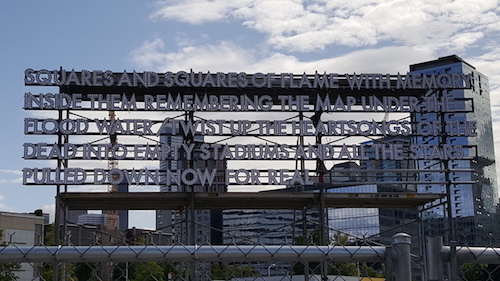
I know that last one is hard to read, but it's a reprisal of the text on the first billboard, only in lights: "Squares and squares of flame with memory inside them remembering the map under the flood water twist up the heartsongs of the dead into empty stadiums and all the stars pulled down now for real." After you read your way around the billboards, you arrive at the end, which is the beginning. Montgomery seems to be lamenting our loss, not damning us for losing everything. He's not quite Ozymandias, urging us to look and despair. Instead, he's demanding that we find the beauty in the world we're in the process of discarding.
"The Stars Pulled Down for Real" will be pulled down (for real) on September 5th, so you have less than a week to go enjoy it in real life. I'd encourage you to do so.



